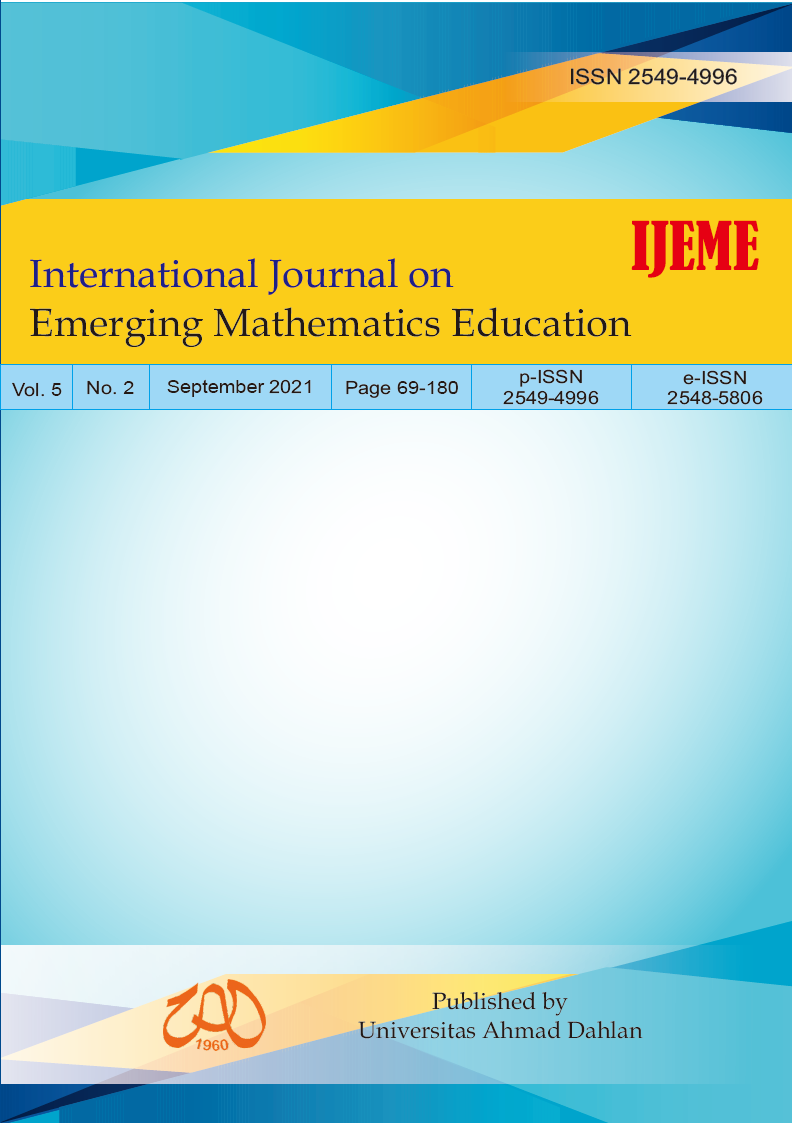Mathematics Curriculum Review in Senior High School Using Curriculum Review Mapping System (CRMS)
DOI:
https://doi.org/10.12928/ijeme.v5i2.18968Keywords:
Mathematics Curriculum, Curriculum review, Curriculum Review Mapping SystemAbstract
Curriculum 2013 that is currently being implemented in Indonesia, still holds many obstacles in its implementation. One of them is the constraints in making a lesson plan. Some tools can help teachers create better lesson plans, one of which is a tool called Curriculum Review Mapping System (CRMS). This research aims to find out the results of national curriculum analysis in mathematics in high school using CRMS and also teacher response to these results. This study used descriptive methods with a qualitative approach. The instruments used are documentation, interviews, and researchers themselves. CRMS uses a technology called a mapping system to analyze the curriculum. The description of the national curriculum analysis results is contained in the result and discussion section. CRMS can be used as a teacher lesson plan analysis tool as teacher preparation before the teacher presents his/her learning in the classroom.
References
Ernawati, & Safitri, R. (2017). Analisis Kesulitan Guru Dalam Merancang Rencana Pelaksanaan Pembelajaran Mata Pelajaran Fisika Berdasarkan Kurikulum 2013 Di Kota Banda Aceh. Jurnal Pendidikan Sains Indonesia (Indonesian Journal of Science Education), 5(2), 49-56.
Fathurrohman, M., Porter, A. L., Worthy, A. L., Abdullah, R., Supriyanto, & Pamungkas, A. S. (2019). Mathematics Curriculum Review by Advancing the Use of Learning Design Map and Subjects Classification. International Journal on Emerging Mathematics Education, 3(1), 27-40.
Goldsmith, L. T., Doerr, H. M., & Lewis, C. C. (2014). Mathematics teachers learning: a conceptual framework and synthesis of research. Journal of Mathematics Teachers Education, 17(1), 5-36.
Gravemeijer, K., Stephan, M., Julie, C., Lin, F., & Ohtani, M. (2017). What Mathematics Education May Prepare Students for the Society of the Future? International Journal of Science and Math Education, 15(1), 105-123.
Haslina, Yusrizal, & Usman, N. (2017). Kinerja Guru Dalam Implementasi Kurikulum 2013 Pada SMA Negeri 5 Lhokseumawe. Jurnal Magister Administrasi Pendidikan Pascasarjana Universitas Syiah Kuala, 5(4), 211-217.
Hikmawati, F. (2017). Metodologi Penelitian (1st ed.). Depok: PT RajaGrafindo Persada.
Ikhsan, K. N., & Hadi, S. (2018). Implementasi Dan Pengembangan Kurikulum 2013. Jurnal Ilmiah Edukasi, 6(1), 193-202.
Kusmaryono, I. (2014). The Importance of Mathematical Power in Mathematics Learning. International Conference on Mathematics, Science, and Education 2014, (September 2014), 35-40. Semarang.
Lee, P. Y. (2010). Designing a mathematics curriculum. Journal on Mathematics Education, 1(1), 1-10.
Muttaqin, I. H., Rahmawati, F., Fathurrohman, M., & Santosa, C. A. H. F. (2020). Mathematics Curriculum Review In Junior Secondary School Level: Implementation Of Web-Based CRMS. International Journal on Emerging Mathematics Education, 4(2), 95-104.
Palobo, M., Sianturi, M., Marlissa, I., Purwanty, R., Dadi, O., & Nur, A. S. (2018). Analysis of Teachers ’ Difficulties on Developing Curriculum 2013 Lesson Plans. 1 St International Conference on Social Sciences (ICSS 2018), 226, 1319-1324.
Republik Indonesia. (2003). Undang-Undang Republik Indonesia Nomor 20 Tahun 2003 Tentang Sistem Pendidikan Nasional. Jakarta.
Republik Indonesia. (2016). Peraturan Menteri Pendidikan dan Kebudayaan Nomor 22 Tahun 2016 Tentang Standar Proses Pendidikan Dasar dan Menengah. Jakarta.
Rifai, N., Fauzan, Wahdi, S., & Bahrissalim. (2014). Integrasi Keilmuan Dalam Pengembangan Kurikulum Di UIN Se-Indonesia. Tarbiya, 1(1), 13-34.
Santi, D., Sugiarti, T., & K, A. I. (2015). Pengembangan Perangkat Pembelajaran Matematika Realistik Pada Pokok Bahasan Lingkaran Kelas VIII SMP. Kadikma, 6(1), 85-94.
Sealey, P., & Noyes, A. (2010). On the relevance of the mathematics curriculum to young people. The Curriculum Journal, 21(September 2010), 239-253.
Setiadi, H. (2016). Pelaksanaan Penilaian Pada Kurikulum 2013. Jurnal Penelitian Dan Evaluasi Pendidikan, 20(2), 166-178.
Sugiyono. (2013). Metode Penelitian Pendidikan (Pendekatan Kuantitatif, Kualitatif, dan R&D) (18th ed.). Bandung: Alfabeta.
Sukmadinata, N. S. (2005). Metode Penelitian Pendidikan. Bandung: PT Remaja Rosdakarya.
Wulandari, E. (2019). Profil Kemampuan Menyusun Rencana Pelaksanaan Pembelajaran Saintifik Oleh Calon Guru Matematika. Jurnal Pengembangan Pembelajaran Matematika (JPPM), I(2), 30-37.
Downloads
Published
How to Cite
Issue
Section
License
License and Copyright Agreement
In submitting the manuscript to the journal, the authors certify that:
- They are authorized by their co-authors to enter into these arrangements.
- The work described has not been formally published before, except in the form of an abstract or as part of a published lecture, review, thesis, or overlay journal. Please also carefully read the International Journal on Emerging Mathematics Education (IJEME) Author Guidelines at http://journal.uad.ac.id/index.php/IJEME/about/submissions#authorGuidelines
- That it is not under consideration for publication elsewhere,
- That its publication has been approved by all the author(s) and by the responsible authorities, tacitly or explicitly, of the institutes where the work has been carried out.
- They secure the right to reproduce any material that has already been published or copyrighted elsewhere.
- They agree to the following license and copyright agreement.
Copyright
Authors who publish with the International Journal on Emerging Mathematics Education (IJEME) agree to the following terms:
- Authors retain copyright and grant the journal the right of first publication with the work simultaneously licensed under a Creative Commons Attribution License (CC BY-SA 4.0) that allows others to share the work with an acknowledgment of the work's authorship and initial publication in this journal.
- Authors are able to enter into separate, additional contractual arrangements for the non-exclusive distribution of the journal's published version of the work (e.g., post it to an institutional repository or publish it in a book), with an acknowledgment of its initial publication in this journal.
- Authors are permitted and encouraged to post their work online (e.g., in institutional repositories or on their website) prior to and during the submission process, as it can lead to productive exchanges, as well as earlier and greater citation of published work.
![]()
Ciptaan disebarluaskan di bawah Lisensi Creative Commons Atribusi-BerbagiSerupa 4.0 Internasional.





